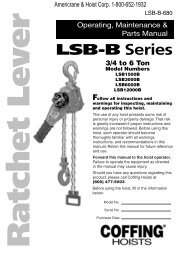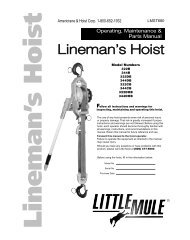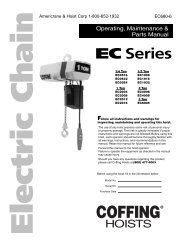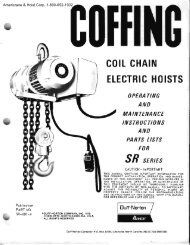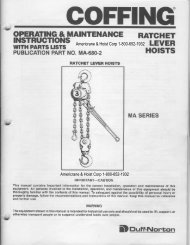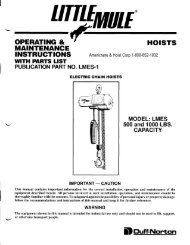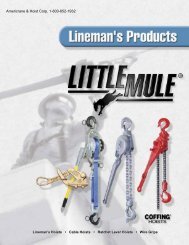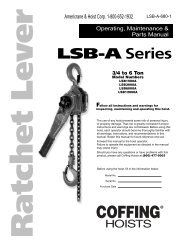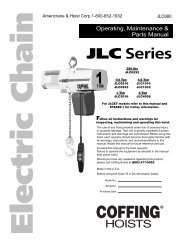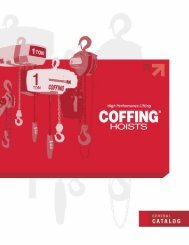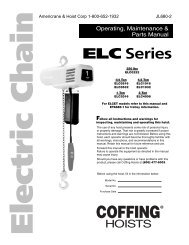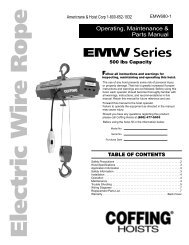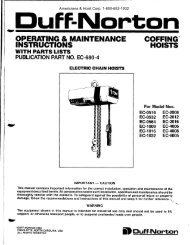ELCMT Series, JLMT 680-1 - Coffing Hoists, Coffing Hoist Parts
ELCMT Series, JLMT 680-1 - Coffing Hoists, Coffing Hoist Parts
ELCMT Series, JLMT 680-1 - Coffing Hoists, Coffing Hoist Parts
- No tags were found...
Create successful ePaper yourself
Turn your PDF publications into a flip-book with our unique Google optimized e-Paper software.
Country Club RoadP.O. Box 779Wadesboro, NC 28170 USATEL: (800) 477-5003FAX: (800) 374-6853INSPECTION AND MAINTENANCE CHECK LISTELECTRIC POWERED OVERHEAD CHAIN HOISTType of <strong>Hoist</strong> ___________________________________________________________Location _______________________________________________________________Manufacturer___________________________________________________________Capacity (Tons)________________________________________________________Original Installation Date ______________________________________________Manufacturer’s Serial No. ______________________________________________Item Frequency of Inspection Possible Deficiencies OK ActionRequiredFrequent PeriodicDaily Monthly 1-12 Mo.Operating Controls * * * Any deficiency causing improper operationLimit Switches * * * 1. Any deficiency causing improper operation2. Switch sticks or does not open circuit when tripped.Motor Brake * * * 1. Slippage or excessive drift2. Glazing, contamination or excessive wearHooks* * * Excessive throat opening 15% bent or twisted more than 10degrees, damaged hook latch, wear, chemical damage,worn hook bearing. Cracks (use dye penetrant, magnetic orother suitable detection method)* * * Cracks, excessive wear or other damage which may impairSuspension Lugthe strength of the lug. Cracks (use dye penetrant,magnetic particle or other suitable detection method)Chain * * * Inadequate lubrication, excessive wear or stretch, cracked,damaged or twisted links, corrosion or foreign substanceHook and SuspensionLug Connections* Cracks, bending, stripped threadsPins, Bearings, BushingsShafts, Couplings, Chain Guides* Excessive wear, corrosion, cracks, distortionNuts, Bolts, Screws * Looseness, stripped and damaged threads, corrosionLoad SheavesHousings, Load Block* Distortion, cracks, and excessive wear.Build-up of foreign substances* Cracks, distortion. Excessive wear, internal build-up offoreign substancesWiring and Terminals * Fraying, defective insulationContact Block, ReversingContactors, other Electrical * Loose connections, burned or pitted contactsApparatus & TerminalsSupporting Structure and TrolleyDamage or wear which restricts ability to support* imposed loadsNameplates, Decals,Warning Labels* Missing, damaged or illegibleGear Oil * Low level or needs changingNOTE: Refer to Maintenance and Inspection Sections of the <strong>Hoist</strong>-Maintenance Manual for further details.FREQUENCY OF INSPECTIONFrequent — Indicates items requiring inspection daily to monthly. Daily inspections may be performed by the operator if properly designated.Periodic — Indicates items requiring inspection monthly to yearly. Inspections to be performed by or under the direction of a properly designated period. Theexact period of inspection will depend on frequency and type of usage. Determination of this period will be based on the user’s experience. It isrecommended that the user begin with a monthly inspection and extend the periods to quarterly, semi-annually or annually based on user’s monthlyexperience.Figure 13A — Recommended Inspection and Maintenance Check ListNOTE: This inspection and maintenance check list is in accordance with our interpretation of the requirements of the SafetyStandard for Overhead <strong><strong>Hoist</strong>s</strong> ASME B30.16. It is, however, the ultimate responsibility of the employer/user to interpret andadhere to the applicable requirements of this safety standard.24



